Kyoto: A Buddhist View (Part 3)
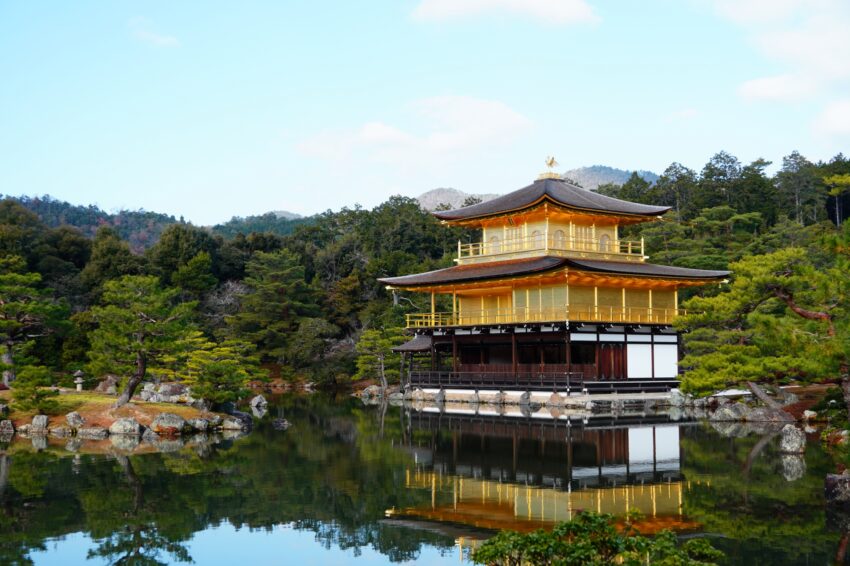
We continue with author Nicholas Lemon’s travelogue of popular sites in Kyoto, with an emphasis on their history as related to Buddhism.
Let’s Talk About Gold
To be totally up front with you, I am not a fan of gold. I don’t like the color. I don’t see any inherent value in it beyond artistry and as a conductor. And I struggle with understanding how gold; a color typically used to illustrate greed in the West is the focal point of a Buddhist temple (examples of this symbolism in Western folklore range from Midas – to the dragon Fafnir in Norse mythology– to Scrooge McDuck). But Kinkaku-ji’s pavilion wasn’t always as gilded as it is today. Shōgun Ashikaga Yoshimitsu was the founding patron of the complex, but it wasn’t donated to the Rinzai Zen sect until his death in 1408 CE as per his will. He purchased the land from descendants of the renowned waka poet, Saionji Kintsune in 1397 CE.
The Ōnin war (centered in Kyoto from 1467 to 1477 CE) laid waste to the entire temple complex, and barely left the pavilion in its place. In the dawn of the Edo period, Abbot Saisho Shotai (1548-1607 CE) was appointed by shogun Tokugawa Ieyasu to head Rokuon-ji, and the temple was sponsored and designated as an official center for Zen practice. However, the Meiji restoration period (1868-1912 CE) was a period of civil war, and bitter feuds erupted between people of all different factions.
As a result, the temple lost all of its financial support and fell upon hard times. The pavilion was in such disrepair that by 1886 the pavilion’s gold leaf was almost completely peeled off. Attempts at restoring gold leaf to the original Kukkyō-chō (究竟頂literally “research spire”, the third floor that was modeled in a Chinese Chan/Zen variation) and at repairing the bottom two floors was further disrupted in 1950, when the Second World War was in the living memories of everyone, a tragic novice monk, Hayashi Yoken, burned it down, presumably because he struggled with mental illness (schizophrenia and a persecution complex). The deed resulted in a speculative public discourse on Yoken’s motivations that could be said to have culminated into Yukio Mishima’s 1956 novel, The Temple of the Golden Pavilion.
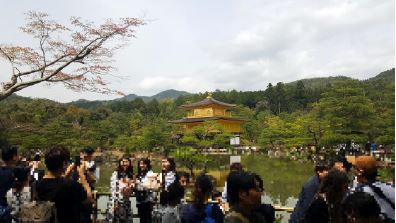
Photo: The popular Kinkaku Golden Pavilion at Rokuon-ji Temple, (May 2018), Nicholas Lemon
The pavilion was swiftly, yet methodically, repaired just a year before the novel’s release, in 1955 and this time it was gilded with gold on the reconstructed Kukkyō-chō as well as the Cho’on-dō (潮音洞literally “tidal sound den”, the second floor designed in the samurai residential style known as buke-zukuri, 武家造literally “samurai construction”). By 1987 the structure was completed in roughly the same way it appears today, but with even thicker gold leaf. The symbolism of the gold structure is more an indication of its roots in the Ashikaga clan, and a continued effort to preserve the legacy of the bakufu (shogunate’s) power center in the Kitayama (北山literally “North Mountain”) district of Kyoto city.
Well, that explains the exterior, and possibly the more popular elements of the pavilion. But there are also the deeper elements of the temple that do designate the structure as Buddhist in culture and tradition.
The interior of the pavilion is off limits to the average tourist, but if you look across the garden pond into the ground floor the Hōssui-in (放水院)— which is built in the shinden-zukuri style (寝殿造the Heian-kyō palatial style of garden architecture) —you would see statues of Gautama Buddha. The structure symbolically serves as a shariden (舎利殿, literally “reliquary hall”) that is said to contain the ashes of the Buddha. The unseen interior of the Cho’on-dō (second floor) contains murals surrounding a statue of the bodhisattva of mercy and compassion- Kannon.
Understanding a Bodhisattva
For me, this is symbolic in two ways. For one, Kannon is an emanation of the Buddha (in my view) that represents a conscientious mind that hears the beckoning of those experiencing the worst of tribulations, yet like a guardian angel, she remains unseen by the common gaze. And secondly, the position of Kannon above Gautama Buddha represents the fact that the former is in a vantage point to receive such cries, and the latter is in his position of Samadhi (perfect concentration and meditative consciousness) as he is grounded to the Earth.
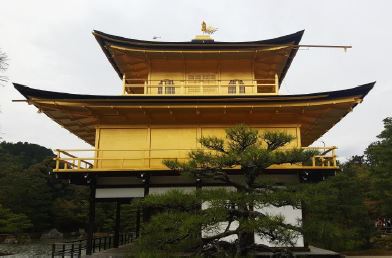
Photo: Kinkaku Golden Pavilion at Rokuon-ji Temple, (May 2018), Nicholas Lemon
The Buddha is often an archetype for one who is grounded in their views and equanimous in the face of tribulations. He is an archetype for the individual coming to grips with adversity and overcoming that adversity with sheer determination and mindfulness.
Kannon is a bodhisattva that represents compassion and the understanding we feel for others with whom we share an empathic connection. Kannon has her history in an early Chinese syncretic blend of folk religion and Buddhism that developed sometime in the Song dynasty (960-1279 CE). Before then, Kannon was imagined as a masculine figure with differing attributes, as opposed to the feminine form that assumes the divine feminine visage. The Chinese alias given to Kannon is Guanyin (觀音contraction of觀世音 “perceiver of the sounds of the world”) and her somewhat anomalous Sanskrit appellation is Avalokiteśvara.
I say anomalous because the –īśvara suffix of her name is more keeping in the tradition of Hindu doctrinal worship of Shiva as a creator god of the universe. This cosmology is not shared beyond Hindu projections onto Buddhism (this happens in areas of majority Hindu populations), and so this appellation is somewhat out of place. For me, these signs of syncretism trouble notions of what is “truth” in the orthopraxy (traditional practice for the sake of proper conduct) of lay people in Buddhism or any other belief system.
However, I respect the archetype of Kannon as being a symbol of compassion personified because she becomes a useful aid for teaching ethical principles to people, like Sakanoue no Tamuramaro, who struggle with empathy and compassion…
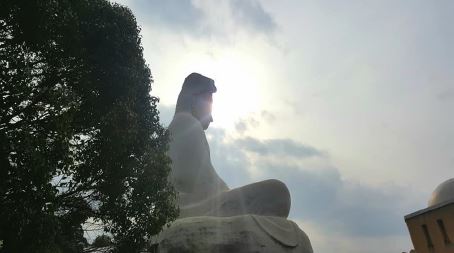
Photo: Kannon Statue, Ryōzen Kannon Pacific War memorial, (February 2020), Nicholas Lemon
The tour concludes with some final reflections next Tuesday on MUSUBI!
Photo Credits:
Additional images provided by the original author (Nicholas Lemon), used with permission
All other content (text) created by the original author and © 2023 MUSUBI by Borderlink
RELATED
-
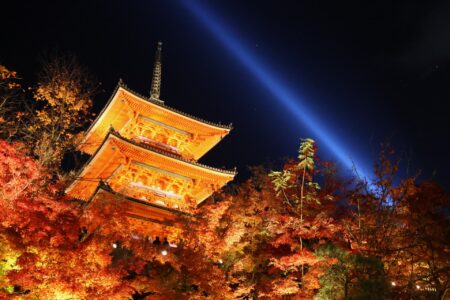
Kyoto: A Buddhist View (Part 1)
Top Photo: LeonardoYasuさん on PhotoAC Over the next week, join author Nicholas Lemon for an insightful and uniq… -
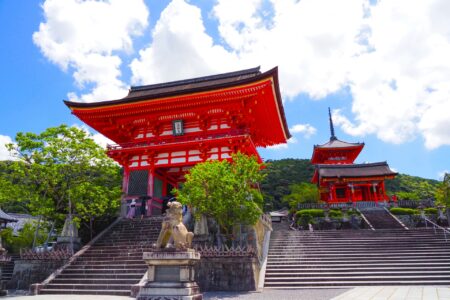
Kyoto: A Buddhist View (Part 2)
Top Photo: photoBさん on PhotoAC We continue with author Nicholas Lemon’s travelogue of popular sites in K… -
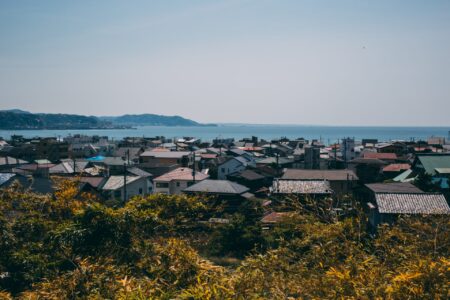
A Warrior’s Town Turned Coastal City
Top Photo: charlesdeluvio on Unsplash Japan is a country that has a lot to offer. Often times when people visi…
PEOPLE

Nicholas Lemon
From the USA
He has lived in Japan since 2016 as a full-time teacher, graduate student, and part-time tour guide in Kyoto for two years


